-

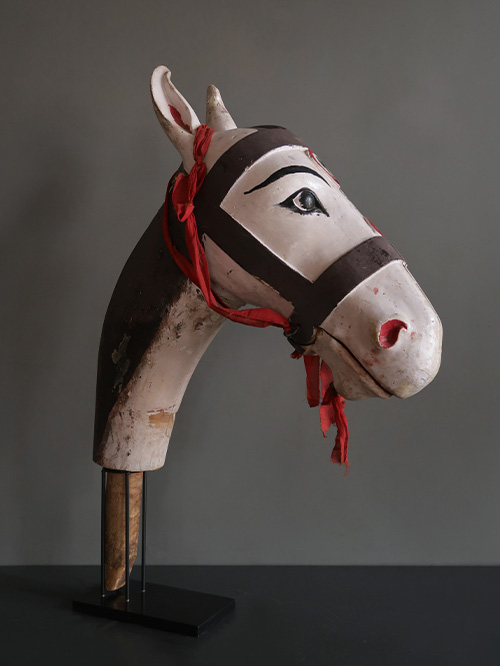
Konkan Region (Western India)
wood, polychromed
A painted wooden horse dancing mask with an articulated jaw. The head is worn through use but still shows its typical trappings.
This is a tribal dancing masks from the Konkan region used in the Perni Zagor, a folk play danced by Christian Gaud tribals. Perni Zagor is an indigenous dance-drama form of the Perni community of Goa. This is an ancient art form and is believed to have evolved on the banks of the Zuari river. It has its origins in fertility rites related to Neolithic shamanism. The dancers don wooden masks while performing the musical drama. The masks represent deities, animals, birds and demons. The characters are derived from various episodes in Hindu mythology. Perni Zagor is currently performed by only a few families in the community and is almost on the verge of extinction.
Size (cms): 86.5(H) x 57(W) x 17(D)
Size (inches): 34(H) x 22.5(W) x 6.5(D)
-
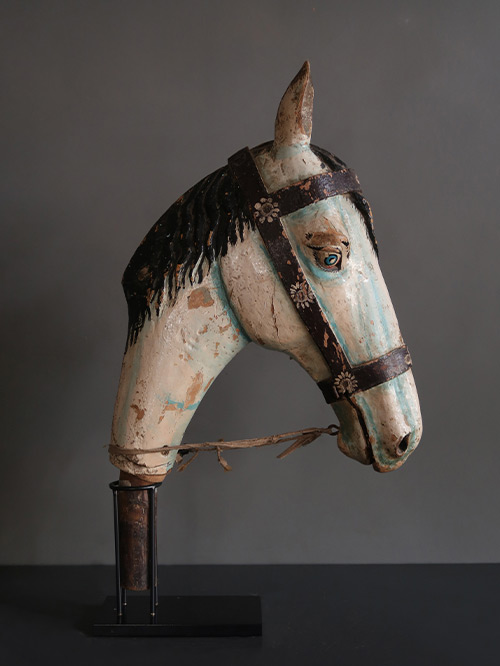
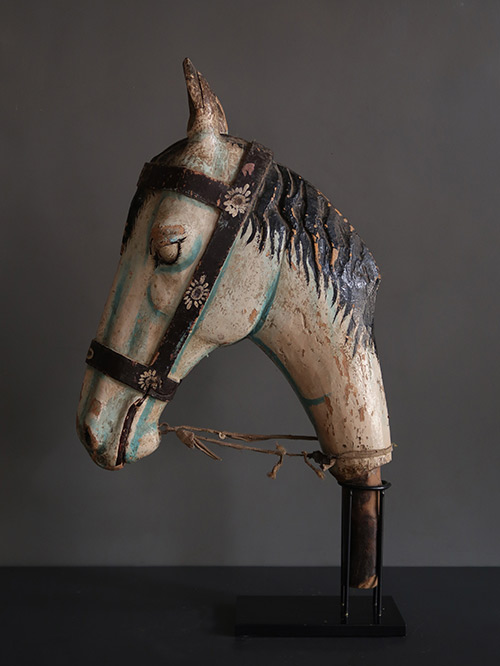
Konkan Region (Western India)
wood, polychromed
A painted wooden horse dancing mask with an articulated jaw. The head is worn through use but still shows its typical trappings.
This is a tribal dancing masks from the Konkan region used in the Perni Zagor, a folk play danced by Christian Gaud tribals. Perni Zagor is an indigenous dance-drama form of the Perni community of Goa. This is an ancient art form and is believed to have evolved on the banks of the Zuari river. It has its origins in fertility rites related to Neolithic shamanism. The dancers don wooden masks while performing the musical drama. The masks represent deities, animals, birds and demons. The characters are derived from various episodes in Hindu mythology. Perni Zagor is currently performed by only a few families in the community and is almost on the verge of extinction.
Size (cms): 77(H) x 44(W) x 17(D)
Size (inches): 30.5(H) x 17.5(W) x 6.5(D)
-

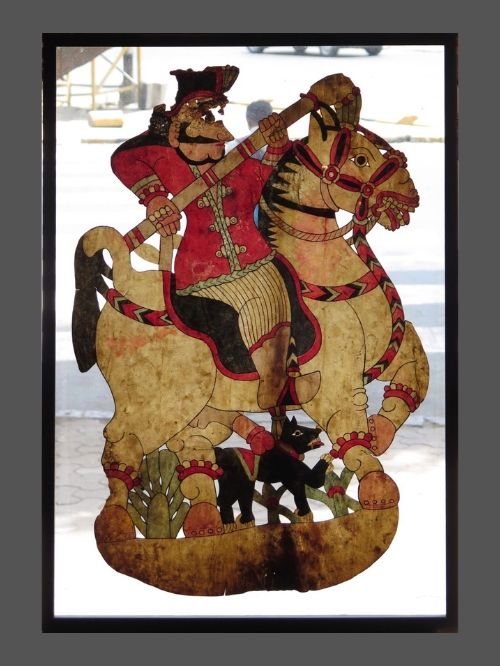
Karnataka (South India)
Framed Leather Shadow Puppet
The art of puppetry, called Togalugombayeta in Karnataka, involves acting out well known epic episodes using puppets made of flat leather pieces operated by a stick. The perforated leather is illuminated from behind, making this a form of shadow theatre. It is thought that the puppets were invented to avoid having gods and goddesses – who feature prominently in Indian epics like the Ramayana and Mahabharata – depicted by humans.
Size(cms): 91 (H) x 62 (L)
Size(inches): 35.8 (H) x 13.4 (L)
-
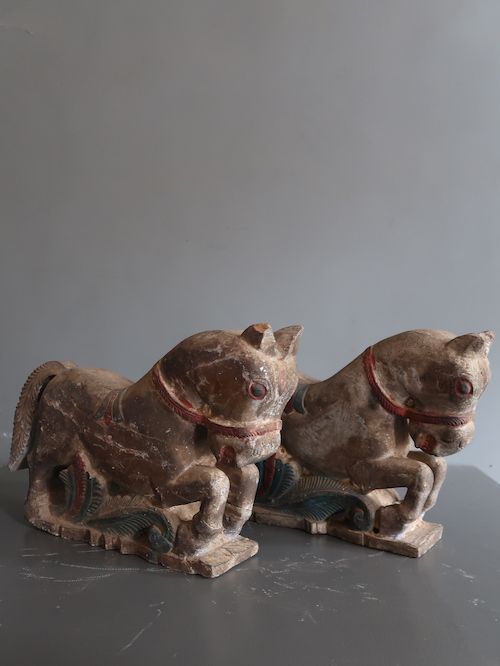
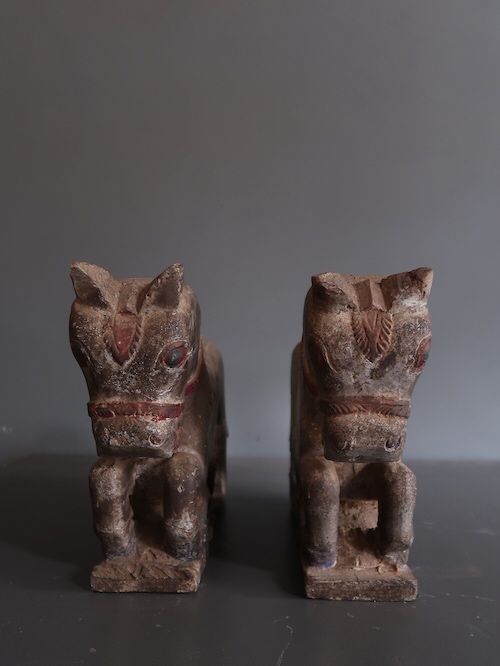
Andhra Pradesh (South India)
Wood, polychromed
These horse brackets once formed the two ends of a door lintel. The horse or ashva was a very popular motif in architectural wood carvings in South India. Its prototype, the divine Uchchaihshravas emerged from the churning of the ocean. It was white and endowed with wings. The god Indra appropriated it and, after cutting its wings to ensure that it would remain on earth, donated it to mankind.
The horse played a pivotal role in establishing the supremacy of kings, as demonstrated, for instance by the great horse sacrifice, the Ashvamedha, which might have been established in the course of the Vedic period. Equestrian motifs appear prominently in Indian art, for example in Orissan sculpture of the 12th and 13th centuries, and in that of the late Vijaynagara and Nayak periods (early 16th to early 18th century) in southern India. There is a branch of literature specialising in the training of horses, which contains detailed passages on colouring, proportions, gait, auspicious and inauspicious marks and lists of appropriate names for horses.
Size(cms): 27 (H) x 41 (W) x 9 (D)
Size(inches): 10.5 (H) x 16 (W) x 3.5 (D)
-
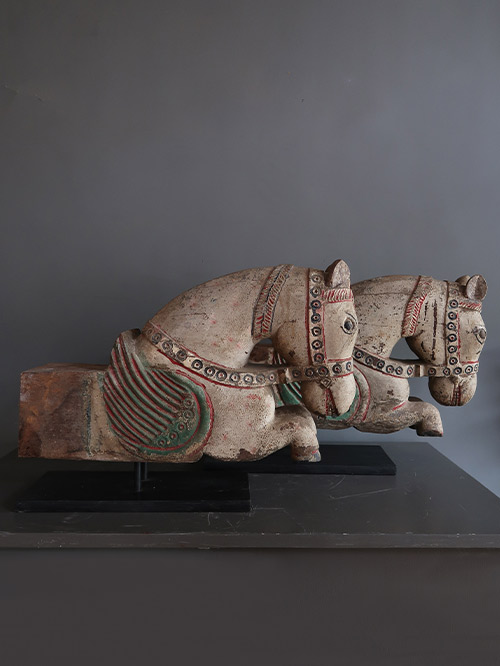

Andhra Pradesh (South India)
Wood
These horse brackets once formed the two ends of a door lintel. The horse or ashva was a very popular motif in architectural wood carvings in South India. Its prototype, the divine Uchchaihshravas emerged from the churning of the ocean. It was white and endowed with wings. The god Indra appropriated it and, after cutting its wings to ensure that it would remain on earth, donated it to mankind.
The horse played a pivotal role in establishing the supremacy of kings, as demonstrated, for instance by the great horse sacrifice, the Ashvamedha, which might have been established in the course of the Vedic period. Equestrian motifs appear prominently in Indian art, for example in Orissan sculpture of the 12th and 13th centuries, and in that of the late Vijaynagara and Nayak periods (early 16th to early 18th century) in southern India. There is a branch of literature specialising in the training of horses, which contains detailed passages on colouring, proportions, gait, auspicious and inauspicious marks and lists of appropriate names for horses.
Individual Sizes (cms): 36 (H) x 61 (W) x 15 (D)
Individual Sizes (inches): 14.2 (H) x 24 (W) x 5.9 (D)
-
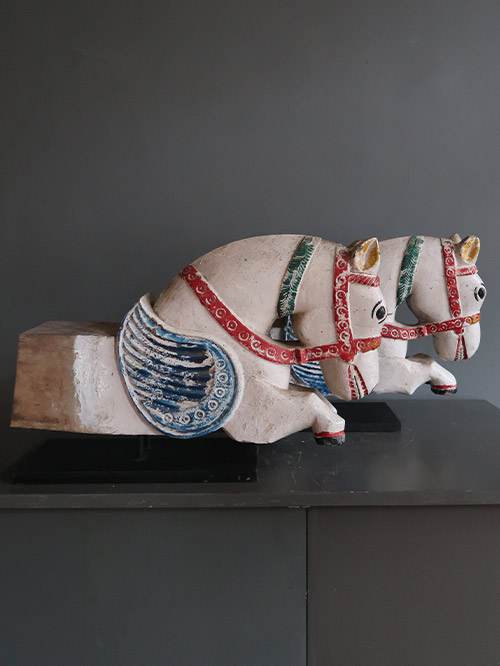
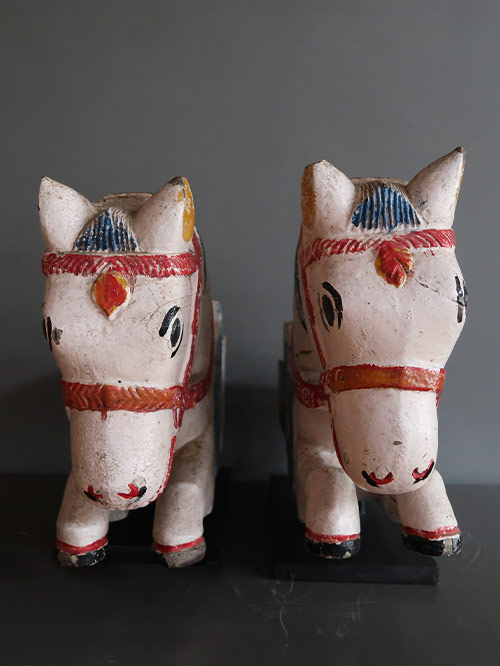
Andhra Pradesh (South India)
Wood
These horse brackets once formed the two ends of a door lintel. The horse or ashva was a very popular motif in architectural wood carvings in South India. Its prototype, the divine Uchchaihshravas emerged from the churning of the ocean. It was white and endowed with wings. The god Indra appropriated it and, after cutting its wings to ensure that it would remain on earth, donated it to mankind.
The horse played a pivotal role in establishing the supremacy of kings, as demonstrated, for instance by the great horse sacrifice, the Ashvamedha, which might have been established in the course of the Vedic period. Equestrian motifs appear prominently in Indian art, for example in Orissan sculpture of the 12th and 13th centuries, and in that of the late Vijaynagara and Nayak periods (early 16th to early 18th century) in southern India. There is a branch of literature specialising in the training of horses, which contains detailed passages on colouring, proportions, gait, auspicious and inauspicious marks and lists of appropriate names for horses.
Individual Size (cms): 40(H) x 64(W) x 18(D)
Individual Size (inches): 15.5(H) x 25(W) x 7(D)
-
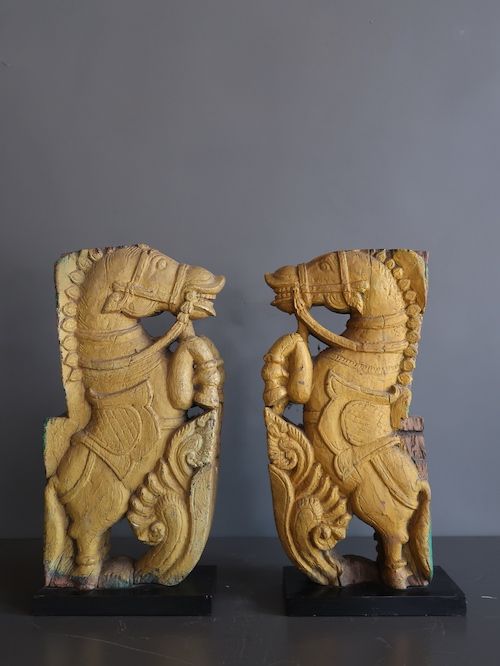
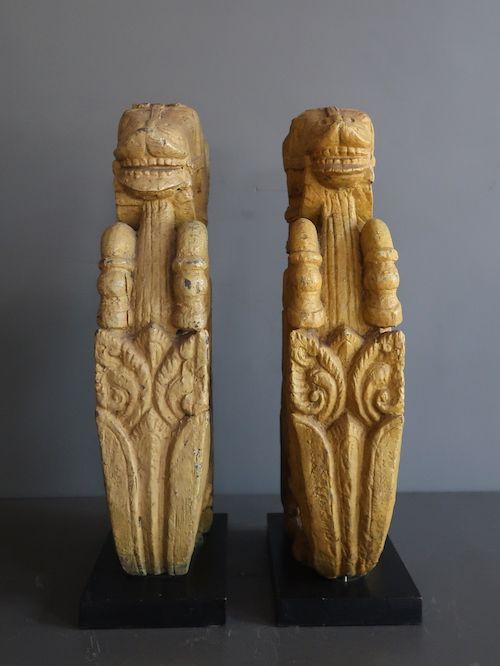
Andhra Pradesh (South India)
Wood, polychromed
These horse brackets once formed the two ends of a door lintel. The horse or ashva was a very popular motif in architectural wood carvings in South India. Its prototype, the divine Uchchaihshravas emerged from the churning of the ocean. It was white and endowed with wings. The god Indra appropriated it and, after cutting its wings to ensure that it would remain on earth, donated it to mankind.
The horse played a pivotal role in establishing the supremacy of kings, as demonstrated, for instance by the great horse sacrifice, the Ashvamedha, which might have been established in the course of the Vedic period. Equestrian motifs appear prominently in Indian art, for example in Orissan sculpture of the 12th and 13th centuries, and in that of the late Vijaynagara and Nayak periods (early 16th to early 18th century) in southern India. There is a branch of literature specialising in the training of horses, which contains detailed passages on colouring, proportions, gait, auspicious and inauspicious marks and lists of appropriate names for horses.
Size individual (cms): 47 (H) x 10 (W) x 23 (D)
Size individual (inches): 18.5 (H) x 4 (W) x 9 (D)
-
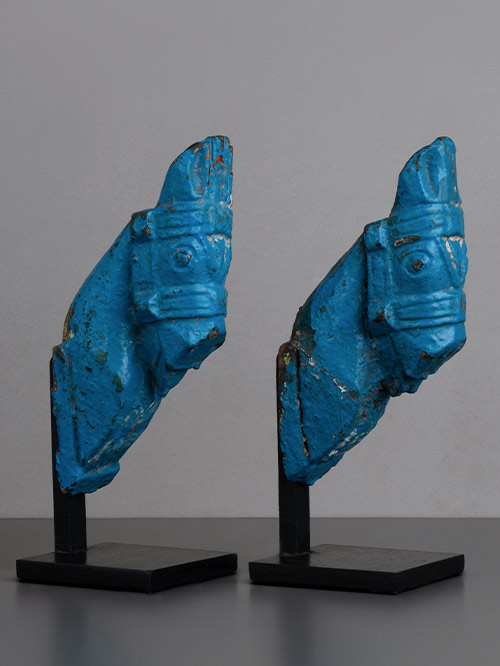
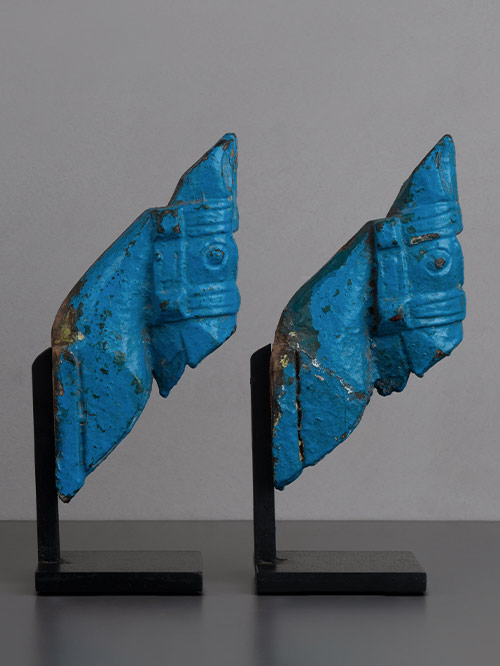
Andhra Pradesh (South India)
Wood, extensively polychromed
These horse brackets once formed the two ends of a door lintel. The horse or ashva was a very popular motif in architectural wood carvings in South India. Its prototype, the divine Uchchaihshravas emerged from the churning of the ocean. It was white and endowed with wings. The god Indra appropriated it and, after cutting its wings to ensure that it would remain on earth, donated it to mankind.
The horse played a pivotal role in establishing the supremacy of kings, as demonstrated, for instance by the great horse sacrifice, the Ashvamedha, which might have been established in the course of the Vedic period. Equestrian motifs appear prominently in Indian art, for example in Orissan sculpture of the 12th and 13th centuries, and in that of the late Vijaynagara and Nayak periods (early 16th to early 18th century) in southern India. There is a branch of literature specialising in the training of horses, which contains detailed passages on colouring, proportions, gait, auspicious and inauspicious marks and lists of appropriate names for horses.
Individual Sizes (cms):28(H) x 10(W) x 13(D)
Individual Sizes (inches): 11(H) x 4(W) x 5(D)
-
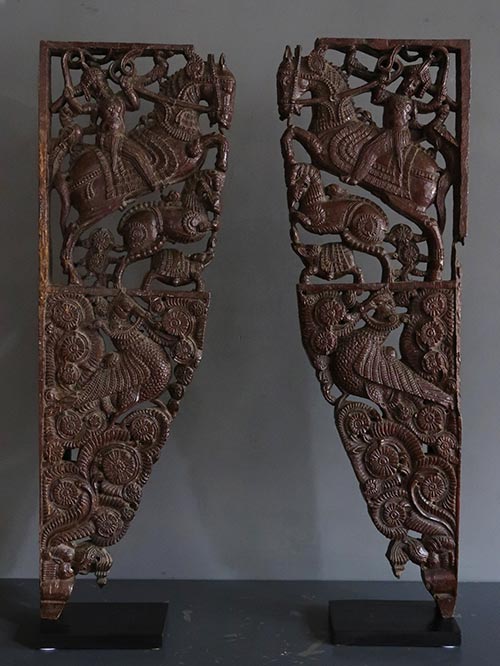
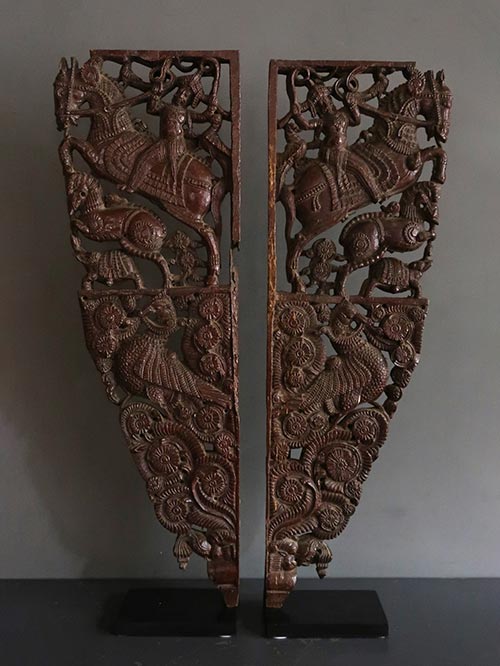
Tamil Nadu
Wood
A pair of extremely fine and large carved and pierced doorway brackets, from the entrance door of a Chettinad mansion. They depict a dense arrangement comprising elaborately caparisoned rearing horses with turbaned and ornamented riders holding whips in the upper register. The pointed turbans worn by these riders is an indication of their royal status. The raised forelegs of the horses rest on the heads of rearing Vyalis – open mouthed and with bulging eyes, who in turn are supported by the trunks of diminutive elephants. At the lower end are parrots perched vertically. The remarkable density of the composition is achieved by filling almost every available space with swirling foliage.
Size individual (cms): 96 (H) x 31 (W) x 15 (D)
Size individual (inches): 37.8 (H) x 12.2 (W) x 6 (D)



















